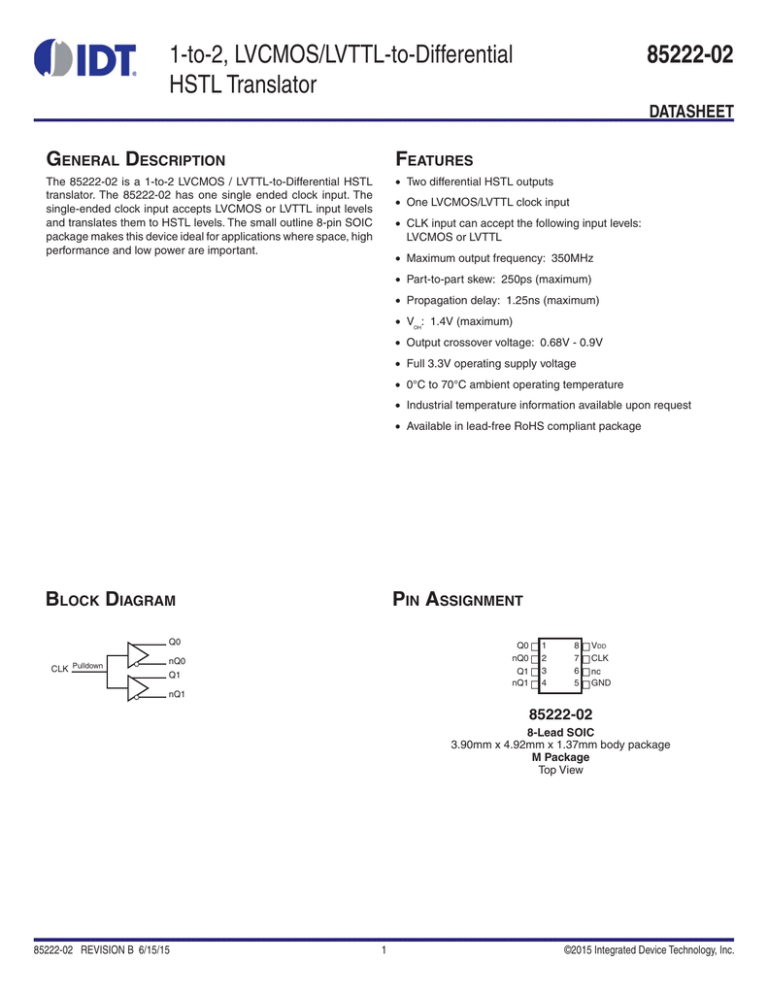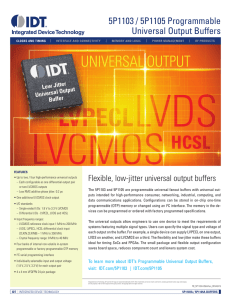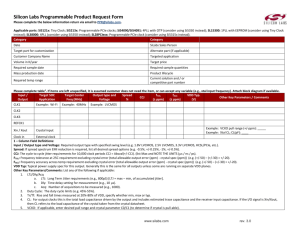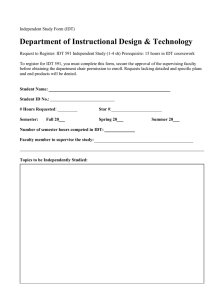
85222-02
1-to-2, LVCMOS/LVTTL-to-Differential
HSTL Translator
DATASHEET
GENERAL DESCRIPTION
FEATURES
The 85222-02 is a 1-to-2 LVCMOS / LVTTL-to-Differential HSTL
translator. The 85222-02 has one single ended clock input. The
single-ended clock input accepts LVCMOS or LVTTL input levels
and translates them to HSTL levels. The small outline 8-pin SOIC
package makes this device ideal for applications where space, high
performance and low power are important.
• Two differential HSTL outputs
• One LVCMOS/LVTTL clock input
• CLK input can accept the following input levels:
LVCMOS or LVTTL
• Maximum output frequency: 350MHz
• Part-to-part skew: 250ps (maximum)
• Propagation delay: 1.25ns (maximum)
• VOH: 1.4V (maximum)
• Output crossover voltage: 0.68V - 0.9V
• Full 3.3V operating supply voltage
• 0°C to 70°C ambient operating temperature
• Industrial temperature information available upon request
• Available in lead-free RoHS compliant package
BLOCK DIAGRAM
PIN ASSIGNMENT
Q0
CLK Pulldown
Q0
nQ0
Q1
nQ1
nQ0
Q1
1
2
3
4
8
7
6
5
VDD
CLK
nc
GND
nQ1
85222-02
8-Lead SOIC
3.90mm x 4.92mm x 1.37mm body package
M Package
Top View
85222-02 REVISION B 6/15/15
1
©2015 Integrated Device Technology, Inc.
85222-02 DATA SHEET
TABLE 1. PIN DESCRIPTIONS
Number
Name
1, 2
Q0, nQ0
Output
Differential output pair. HSTL interface levels.
3, 4
Q1, nQ1
Output
Differential output pair. HSTL interface levels.
5
GND
Power
Power supply ground.
6
nc
Unused
7
CLK
Input
Pulldown LVCMOS / LVTTL clock input.
8
V
Power
Positive supply pin.
DD
Type
Description
No connect.
NOTE: Pulldown refers to internal input resistors. See Table 2, Pin Characteristics, for typical values.
NOTE: Unused output pairs must be terminated.
TABLE 2. PIN CHARACTERISTICS
Symbol
Parameter
CIN
Input Capacitance
4
pF
RPULLDOWN
Input Pulldown Resistor
51
kΩ
1-TO-2, LVCMOS/LVTTL-TODIFFERENTIAL
HSTL TRANSLATOR
Test Conditions
Minimum
2
Typical
Maximum
Units
REVISION B 6/15/15
85222-02 DATA SHEET
ABSOLUTE MAXIMUM RATINGS
Supply Voltage, VDD
4.6V
Inputs, VI
-0.5V to VDD + 0.5V
Outputs, IO
Continuous Current
Surge Current
50mA
100mA
Package Thermal Impedance, θJA
112.7°C/W (0 lfpm)
Storage Temperature, TSTG
-65°C to 150°C
N OT E : S t r e s s e s b eyo n d t h o s e l i s t e d u n d e r A b s o l u t e
Maximum Ratings may cause permanent damage to the
device. These ratings are stress specifications only. Functional
operation of product at these conditions or any conditions beyond
those listed in the DC Characteristics or AC Characteristics is
not implied. Exposure to absolute maximum rating conditions for
extended periods may affect product reliability.
TABLE 3A. POWER SUPPLY DC CHARACTERISTICS, VDD = 3.3V±5%, TA = 0°C TO 70°C
Symbol
Parameter
Test Conditions
VDD
Positive Supply Voltage
IDD
Power Supply Current
Minimum
Typical
Maximum
Units
3.135
3.3
3.465
V
50
mA
TABLE 3B. LVCMOS / LVTTL DC CHARACTERISTICS, VDD = 3.3V±5%, TA = 0°C TO 70°C
Symbol
Parameter
VIH
Input High Voltage
Test Conditions
Minimum
Typical
2
VIL
Input Low Voltage
IIH
Input High Current
CLK
VDD = VIN = 3.465V
IIL
Input Low Current
CLK
VDD = 3.465, VIN = 0V
-0.3
Maximum
Units
VDD + 0.3
V
0.8
V
150
µA
-5
µA
TABLE 3C. HSTL DC CHARACTERISTICS, VDD = 3.3V±5%, TA = 0°C TO 70°C
Symbol
Parameter
VOH
Output High Voltage; NOTE 1
Test Conditions
Minimum
Maximum
Units
1.0
Typical
1.4
V
VOL
Output Low Voltage; NOTE 1
0
0.4
V
VOX
Output Crossover Voltage
0.68
0.9
V
VSWING
Peak-to-Peak Output Voltage Swing
0.6
1.4
V
Maximum
Units
350
MHz
1.25
ns
1.0
NOTE 1: All outputs must be terminated with 50Ω to ground.
TABLE 4. AC CHARACTERISTICS, VDD = 3.3V±5%, TA = 0°C TO 70°C
Symbol
Parameter
fMAX
Output Frequency
tPD
Propagation Delay; NOTE 1
Test Conditions
Minimum
0.85
Typical
1.05
tsk(o)
Output Skew; NOTE 2, 3
25
ps
tsk(pp)
Part-to-Part Skew; NOTE 4
250
ps
tR / tF
Output Rise/Fall Time
odc
Output Duty Cycle
20% to 80%
250
500
ps
f ≤ 250MHz
45
55
%
f > 250MHz
40
60
%
All outputs must be terminated with 50W to ground.
NOTE 1: Measured from VDD/2 of the input to the differential output crossing point.
NOTE 2: Defined as skew between outputs at the same supply voltage and with equal load conditions.
NOTE 3: This parameter is defined in accordance with JEDEC Standard 65.
NOTE 4: Defined as skew between outputs on different devices operating at the same supply voltages and with equal load
conditions. Using the same type of inputs on each device, the outputs are measured at the differential cross points.
REVISION B 6/15/15
3
1-TO-2, LVCMOS/LVTTL-TODIFFERENTIAL
HSTL TRANSLATOR
85222-02 DATA SHEET
PARAMETER MEASUREMENT INFORMATION
NOTE: All outputs must be terminated with 50Ω to ground.
3.3V CORE/3.3V OUTPUT LOAD AC TEST CIRCUIT
PART-TO-PART SKEW
OUTPUT SKEW
PROPAGATION DELAY
OUTPUT DUTY CYCLE/PULSE WIDTH/PERIOD
1-TO-2, LVCMOS/LVTTL-TODIFFERENTIAL
HSTL TRANSLATOR
OUTPUT RISE/FALL TIME
4
REVISION B 6/15/15
85222-02 DATA SHEET
APPLICATION INFORMATION
RECOMMENDATIONS FOR UNUSED OUTPUT PINS
OUTPUTS:
HSTL OUTPUT
All outputs must be terminated with 50Ω to ground.
SCHEMATIC EXAMPLE
Figure 2 shows a schematic example of 85222-02. In the example,
the input is driven by a 7 ohm LVCMOS driver with a series
termination. The decoupling capacitor should be physically located
near the power pin. For 85222-02, the unused output need to be
terminated.
Zo = 50 Ohm
VDD=3.3V
-
U1
Q2
Ro ~ 7 Ohm
R6
Driv er_LVCMOS
Zo = 50 Ohm
5
6
7
8
GND
nc
CLK
VDD
nQ1
Q1
nQ0
Q0
4
3
2
1
Zo = 50 Ohm
+
R1
50
43
R2
50 HSTL Input
ICS85222-02
VDD=3.3V
C1
0.1u
Zo = 50 Ohm
Zo = 50 Ohm
+
R3
50
R4 HSTL Input
50
FIGURE 2. 85222-02 HSTL BUFFER SCHEMATIC EXAMPLE
REVISION B 6/15/15
5
1-TO-2, LVCMOS/LVTTL-TODIFFERENTIAL
HSTL TRANSLATOR
85222-02 DATA SHEET
POWER CONSIDERATIONS
This section provides information on power dissipation and junction temperature for the 85222-02.
Equations and example calculations are also provided.
1. Power Dissipation.
The total power dissipation for the 85222-02 is the sum of the core power plus the power dissipated in the load(s).
The following is the power dissipation for VDD = 3.3V + 5% = 3.465V, which gives worst case results.
NOTE: Please refer to Section 3 for details on calculating power dissipated in the load.
•
•
Power (core)MAX = VDD_MAX * IDD_MAX = 3.465V * 50mA = 173.25mW
Power (outputs)MAX = 73.8mW/Loaded Output pair
If all outputs are loaded, the total power is 2 * 82.3mW = 164.6mW
Total Power_MAX (3.465V, with all outputs switching) = 173.25mW + 164.6mW = 337.86mW
2. Junction Temperature.
Junction temperature, Tj, is the temperature at the junction of the bond wire and bond pad and directly affects the reliability of the
device. The maximum recommended junction temperature for HiPerClockSTM devices is 125°C.
The equation for Tj is as follows: Tj = θJA * Pd_total + TA
Tj = Junction Temperature
θJA = Junction-to-Ambient Thermal Resistance
Pd_total = Total device power dissipation (example calculation is in Section 1 above)
TA = Ambient Temperature
In order to calculate junction temperature, the appropriate junction-to-ambient thermal resistance θJA must be used. Assuming a
moderate air flow of 200 linear feet per minute and a multi-layer board, the appropriate value is 103.3°C/W per Table 5 below.
Therefore, Tj for an ambient temperature of 70°C with all outputs switching is:
70°C + 0.337W * 103.3°C/W = 104.8°C. This is below the limit of 125°C.
This calculation is only an example. Tj will obviously vary depending on the number of loaded outputs, supply voltage, air flow,
and the type of board (single layer or multi-layer).
TABLE 5. THERMAL RESISTANCE θJA FOR 8-PIN SOIC, FORCED CONVECTION
θJA by Velocity (Linear Feet per Minute)
Single-Layer PCB, JEDEC Standard Test Boards
Multi-Layer PCB, JEDEC Standard Test Boards
0
200
500
153.3°C/W
112.7°C/W
128.5°C/W
103.3°C/W
115.5°C/W
97.1°C/W
NOTE: Most modern PCB designs use multi-layered boards. The data in the second row pertains to most designs.
1-TO-2, LVCMOS/LVTTL-TODIFFERENTIAL
HSTL TRANSLATOR
6
REVISION B 6/15/15
85222-02 DATA SHEET
3. Calculations and Equations.
The purpose of this section is to derive the power dissipated into the load.
HSTL output driver circuit and termination are shown in Figure 1.
FIGURE 1. HSTL DRIVER CIRCUIT AND TERMINATION
To calculate worst case power dissipation into the load, use the following equations which assume a 50Ω load.
Pd_H is power dissipation when the output drives high.
Pd_L is the power dissipation when the output drives low.
Pd_H = (VOH_MAX /RL) * (VDD_MAX - VOH_MAX)
Pd_L = (VOL_MAX /RL) * (VDD_MAX - VOL_MAX)
Pd_H = (1.4V/50Ω) * (3.465V - 1.4V) = 57.8mW
Pd_L = (0.4V/50Ω) * (3.465V - 0.4V) = 24.52mW
Total Power Dissipation per output pair = Pd_H + Pd_L = 82.3mW
REVISION B 6/15/15
7
1-TO-2, LVCMOS/LVTTL-TODIFFERENTIAL
HSTL TRANSLATOR
85222-02 DATA SHEET
RELIABILITY INFORMATION
TABLE 6. θJAVS. AIR FLOW TABLE 8 LEAD SOIC
θJA by Velocity (Linear Feet per Minute)
Single-Layer PCB, JEDEC Standard Test Boards
Multi-Layer PCB, JEDEC Standard Test Boards
0
200
500
153.3°C/W
112.7°C/W
128.5°C/W
103.3°C/W
115.5°C/W
97.1°C/W
NOTE: Most modern PCB designs use multi-layered boards. The data in the second row pertains to most designs.
TRANSISTOR COUNT
The transistor count for 85222-02 is: 411
1-TO-2, LVCMOS/LVTTL-TODIFFERENTIAL
HSTL TRANSLATOR
8
REVISION B 6/15/15
85222-02 DATA SHEET
PACKAGE OUTLINE - M SUFFIX FOR 8 LEAD SOIC
TABLE 7. PACKAGE DIMENSIONS
SYMBOL
Millimeters
MINIMUM
N
MAXIMUM
8
A
1.35
1.75
A1
0.10
0.25
B
0.33
0.51
C
0.19
0.25
D
4.80
5.00
E
3.80
4.00
e
1.27 BASIC
H
5.80
6.20
h
0.25
0.50
L
0.40
1.27
α
0°
8°
Reference Document: JEDEC Publication 95, MS-012
REVISION B 6/15/15
9
1-TO-2, LVCMOS/LVTTL-TODIFFERENTIAL
HSTL TRANSLATOR
85222-02 DATA SHEET
TABLE 8. ORDERING INFORMATION
Part/Order Number
Marking
Package
Shipping Package
Temperature
ICS85222AM-02LF
5222A02L
8 Lead “Lead-Free” SOIC
tube
0°C to 70°C
ICS85222AM-02LFT
5222A02L
8 Lead “Lead-Free” SOIC
tape & reel
0°C to 70°C
NOTE: Parts that are ordered with an “LF” suffix to the part number are the Pb-Free configuration and are RoHS compliant.
1-TO-2, LVCMOS/LVTTL-TODIFFERENTIAL
HSTL TRANSLATOR
10
REVISION B 6/15/15
85222-02 DATA SHEET
REVISION HISTORY SHEET
Rev
Table
Page
T1
5
6-7
1
2
T2
T3B
2
3
T8
10
1
A
B
B
REVISION B 6/15/15
Description of Change
Date
Added Schematic Example.
Power Considerations - corrected power dissipation in calculations.
7/24/06
Updated Block Diagram with Pulldown for CLK.
Pin Description - changed pin 7 as Pulldown instead of Pullup. Changed note to
reflect Pulldown.
Pin Characteristics - changed Pullup Resistor to Pulldown.
LVCMOS DC Characteristics Table - changed IIH from 5µA max. to 150µA max.
and changed IIL from -150µA min. to -5µA min.
9/12/07
Ordering Information - removed leaded devices.
Features Section - removed reference to leaded devices.
Updated data sheet format.
11
6/15/15
1-TO-2, LVCMOS/LVTTL-TODIFFERENTIAL
HSTL TRANSLATOR
Corporate Headquarters
6024 Silver Creek Valley Road
San Jose, California 95138
Sales
800-345-7015 or +408-284-8200
Fax: 408-284-2775
www.IDT.com
Technical Support
email: clocks@idt.com
DISCLAIMER Integrated Device Technology, Inc. (IDT) and its subsidiaries reserve the right to modify the products and/or specifications described herein at any time and at IDT’s sole discretion. All information in
this document, including descriptions of product features and performance, is subject to change without notice. Performance specifications and the operating parameters of the described products are determined
in the independent state and are not guaranteed to perform the same way when installed in customer products. The information contained herein is provided without representation or warranty of any kind, whether express or implied, including, but not limited to, the suitability of IDT’s products for any particular purpose, an implied warranty of merchantability, or non-infringement of the intellectual property rights of others.
This document is presented only as a guide and does not convey any license under intellectual property rights of IDT or any third parties.
IDT’s products are not intended for use in applications involving extreme environmental conditions or in life support systems or similar devices where the failure or malfunction of an IDT product can be reasonably expected to significantly affect the health or safety of users. Anyone using an IDT product in such a manner does so at their own risk, absent an express, written agreement by IDT.
Integrated Device Technology, IDT and the IDT logo are registered trademarks of IDT. Other trademarks and service marks used herein, including protected names, logos and designs, are the property of IDT or
their respective third party owners.
Copyright 2015. All rights reserved.





